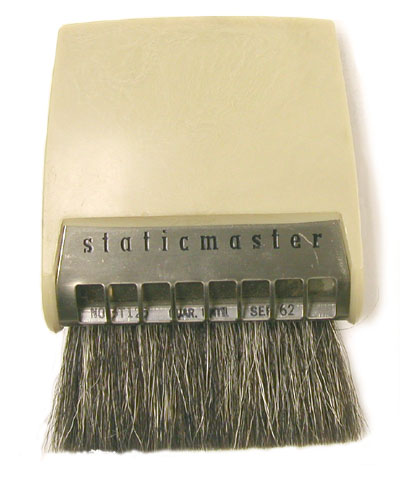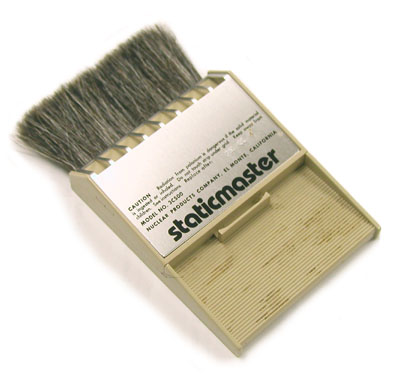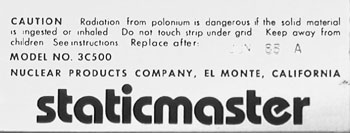Static Eliminators (1960s and 1980s)
Static eliminators of the type sold to the general public have been used to eliminate dust on records, film negatives, lenses, etc. In general, they employ an alpha emitting radioactive source, usually polonium-210, to ionize the air immediately in front of the device. The ions produced in the air (positively charged oxygen and nitrogen molecules, and negatively charged electrons) are then attracted to the object that has the static charge. As a result of the collection of these ions by the object, the charge is reduced or eliminated. Since the object’s surface no longer has a static charge to hold on to the dust particles, the latter are easier to brush off. The static eliminator below left states that it is guaranteed until September 1962. The device below right states that it should be replaced after June 1985.


The Staticmaster (seen above) was first produced in 1950 by the Nuclear Products Company located at 2150 Newport Boulevard in Costa Mesa, California. Judging from their appearance, the first models were ordinary camel's-hair paintbrushes with the polonium strip and its enclosure attached to the ferrule of the brush. Originally, they were "designed to remove dust from film and lenses," but by 1956 the Staticmaster was also being advertised as a device that would remove dust from records. When the seventies rolled around, there was plenty of competition (e.g., the Autocleanica from Audio-Technics, the Dust Bug made by Watts, and RCA's Discwasher), but none, to my knowledge, that were radioactive. Back in the day, I used the Discwasher.
In fabricating the older static eliminators of the type shown here, polonium-210 was adsorbed on the surface of a silicate ion exchange resin which was then heated so that the silica was converted into a ceramic. This meant that the polonium-210 was bound within the ceramic matrix. The beads, approximately 20 to 60 um in diameter, were then affixed with an epoxy resin to a metal (e.g., aluminum) plate. Since the microspheres were not covered with any type of protective coating, an open metal grill was used to prevent the source from being touched. The soft bristle brush was positioned next to the source in order to remove the dust.
The following description from NUREG-1717 describes the fabrication of the sources for the newer static eliminators: "A technology similar to that used in making 241Am sources for smoke detectors is currently being used to make the 210Po sources. The 210Po sources made of ceramic microspheres are no longer used in the manufacturing of static elimination devices in the United States. The 210Po sources made in the United States have a silver backing plate covered by a thin gold foil and a second composite foil of gold and 210Po. These foils are locked together by a pressure weld metallurgy process. The composite foil of gold and 210Po is then gold plated to provide an encapsulated source that is insoluble and inert in most chemicals. The solid metal source is mechanically fastened within a rigid housing and steps are taken to prevent disassembly of the source housing."
The Po-210 activity is often on the order of 200 to 500 uCi at the time of manufacture, but this activity decreases quickly according to the 138 day half-life of Po-210. As such, the effective life of a static eliminator is about one year.

Given the construction of the source, the comment on the label that the polonium is "dangerous" is something of an exaggeration. The polonium microspheres are sufficiently large that it is unlikely that they would be inhaled even if they had become airborne. At the same time, the polonium is bound up in a ceramic matrix so that it should not be assimilated if the spheres were ingested.
The manufacturer is probably doing their best to prevent intentional misuse of the product.
Estimated Doses
Given all this, and the fact that the intensity of the 800 keV gamma ray is very low, the potential exposures are insignificant.
NUREG-1717 estimated a dose equivalent of less than 0.001 mrem/year to an individual who is located 2 meters away from a 500 uCi static eliminator for 2000 hours per year. The exposure rate at two meters was estimated to be 3 x 10-10 rem/hr.
They also calculated an effective dose equivalent of 0.2 mrem per year to an individual who carried a 500 uCi static eliminator in a pocket for 2000 hours per year.
The highest calculated doses were due to the inhalation of Po-210 that had become airborne as a result of a fire. For the purpose of these calculations it was assumed that 0.1% of the polonium was released. The calculated dose to an individual escaping a residential fire was 2 mrem. In this calculation, the assumed source was a single 500 uCi static eliminator that was consumed in the fire. It was also estimated that a firefighter at a warehouse fire might receive an effective dose equivalent of 0.5 mrem. It was assumed that the warehouse contained 600 static eliminators and that the firefighter was wearing a respirator.
Pertinent Regulations
31.3 Certain devices and equipment.
A general license is hereby issued to transfer, receive, acquire, own, possess and use byproduct material incorporated in the following devices or equipment which have been manufactured, tested and labeled by the manufacturer in accordance with the specifications contained in a specific license issued to him by the Commission.
(a) Static elimination device. Devices designed for use as static eliminators which contain, as a sealed source or sources, byproduct material consisting of a total of not more than 500 microcuries of polonium 210 per device.
References
- Radiation Exposure of the U.S. Population from Consumer Products and Miscellaneous Sources. NCRP Report No. 95; 1987.
- Nuclear Regulatory Commission. Systematic Radiological Assessment of Exemptions for Source and Byproduct Materials. NUREG-1717. June 2001.
- Niemeyer, R.G., Case, F.N., Cutshall, N.H. Evaluation of Polonium-210 Static Eliminators. in NUREG/CP-0001. Radioactivity in Consumer Products. 1978.
